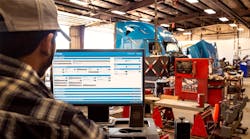Today’s heavy-duty trucks have been called computers on wheels because of the number of sensors that provide data about how the vehicle is performing. As if that weren’t enough, most trucks are equipped with telematics devices that capture and report even more data.
Fleets now have what has been referred to as “an ocean’s worth of data” about each of their vehicles. While that amount of data can seem overwhelming, the reality is that fleet managers do not need to look at every line of data to be able to leverage the information that is now at their fingertips.
See also: The data integration dilemma in trucking
When analyzing data, fleet managers can do several things. First, they need to only focus on the data that falls outside their preset normal operating parameters. Those parameters will be different for each fleet, but there is nothing to be gained by looking at the vehicles that are operating as they should. The focus should be on things that are not going well so adjustments can be made as needed.
The second thing fleet managers need to look at is trend data, especially as it applies to maintenance and repair. Fleets should be collecting data every time an asset is in the shop—whether it is the fleet’s own shop or that of an outside service provider. The data can be analyzed in a number of ways, including looking at all assets of a certain age, those from one particular manufacturer, those with a certain engine, or in a specific duty cycle, etc.
What the fleet manager is looking for is wear and failure trends that can then be leveraged to adjust maintenance schedules or even to schedule trucks into the shop to proactively replace a part or perform a repair before there is an actual on-road failure.
See also: During these disruptive times, technology can keep fleets prepared
For example, if the trend data is saying that a certain component from a particular manufacturer is consistently having an issue after 60,000 miles of operation, the fleet manager may decide to bring all assets with that component operating in similar duty cycles into the shop as the odometer nears 60,000.
Will some components that are replaced still have life in them? That is, of course, a possibility. But the bigger benefit is that the fleet manager may avoid roadside breakdowns for other trucks with that component. Roadside breakdowns are the costliest not only in terms of money spent to perform a repair when the truck is on the side of the road or for towing, but there is also the cost of late deliveries and unhappy customers and drivers.
Since fleets are now operating older assets and likely will continue to do so into 2023 as supply chain issues persist, this more proactive approach to maintenance and repair can pay big dividends.
Jane Clark is vice president of member services for NationaLease. In this position, she is focused on managing the member services operation as well as working to strengthen member relationships, reduce member costs, and improve collaboration within the NationaLease supporting groups. Prior to joining NationaLease, Clark served as area vice president for Randstad, one of the nation’s largest recruitment agencies, and before that, she served in management posts with QPS Cos., Pro Staff, and Manpower Inc.



